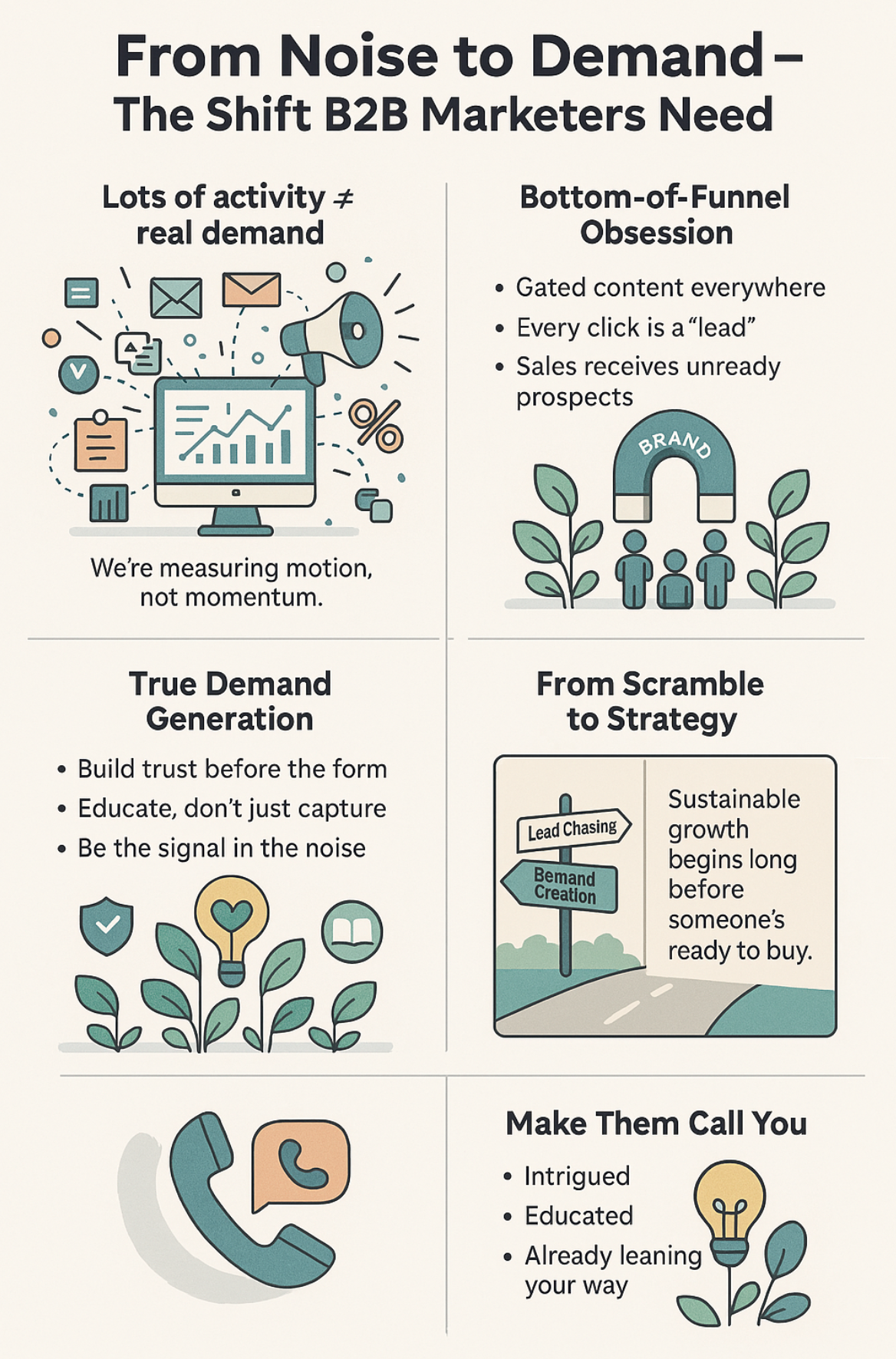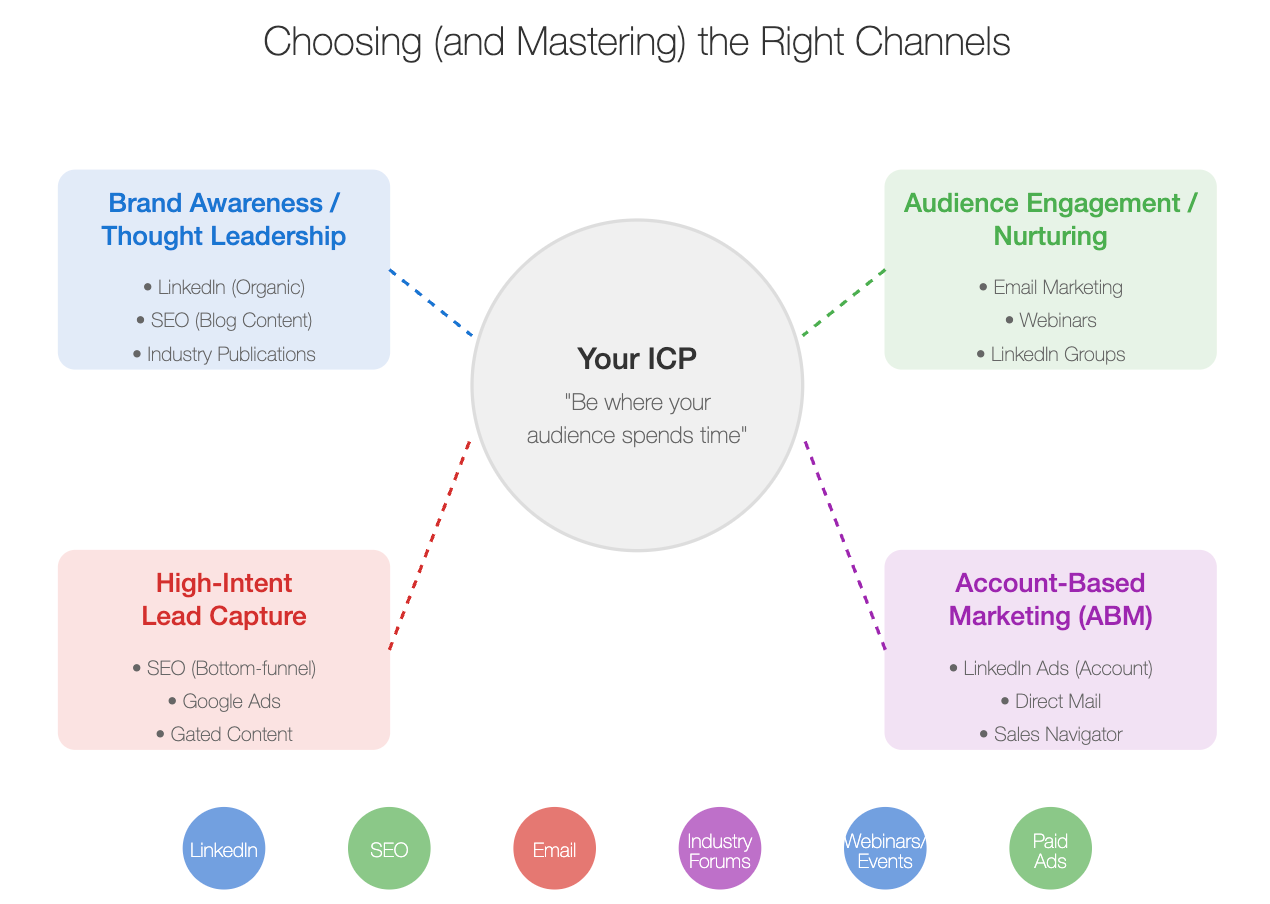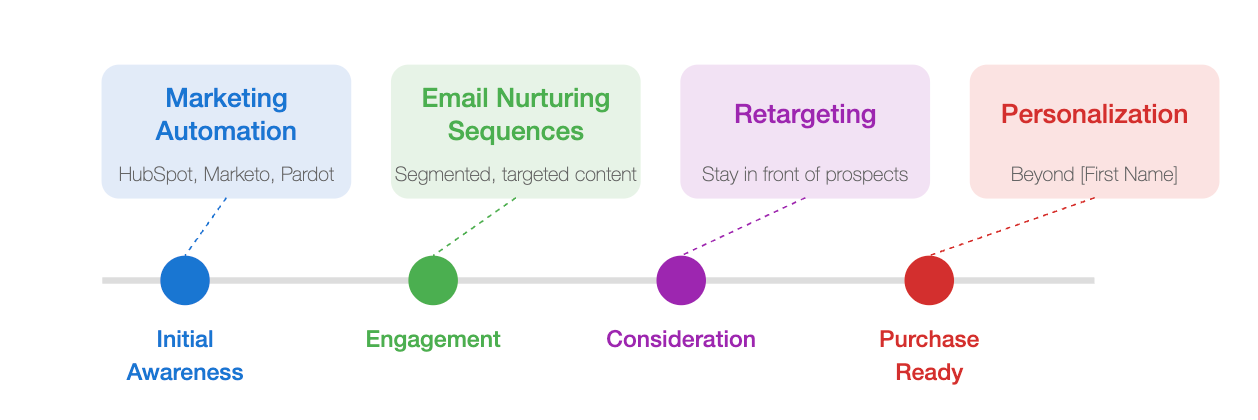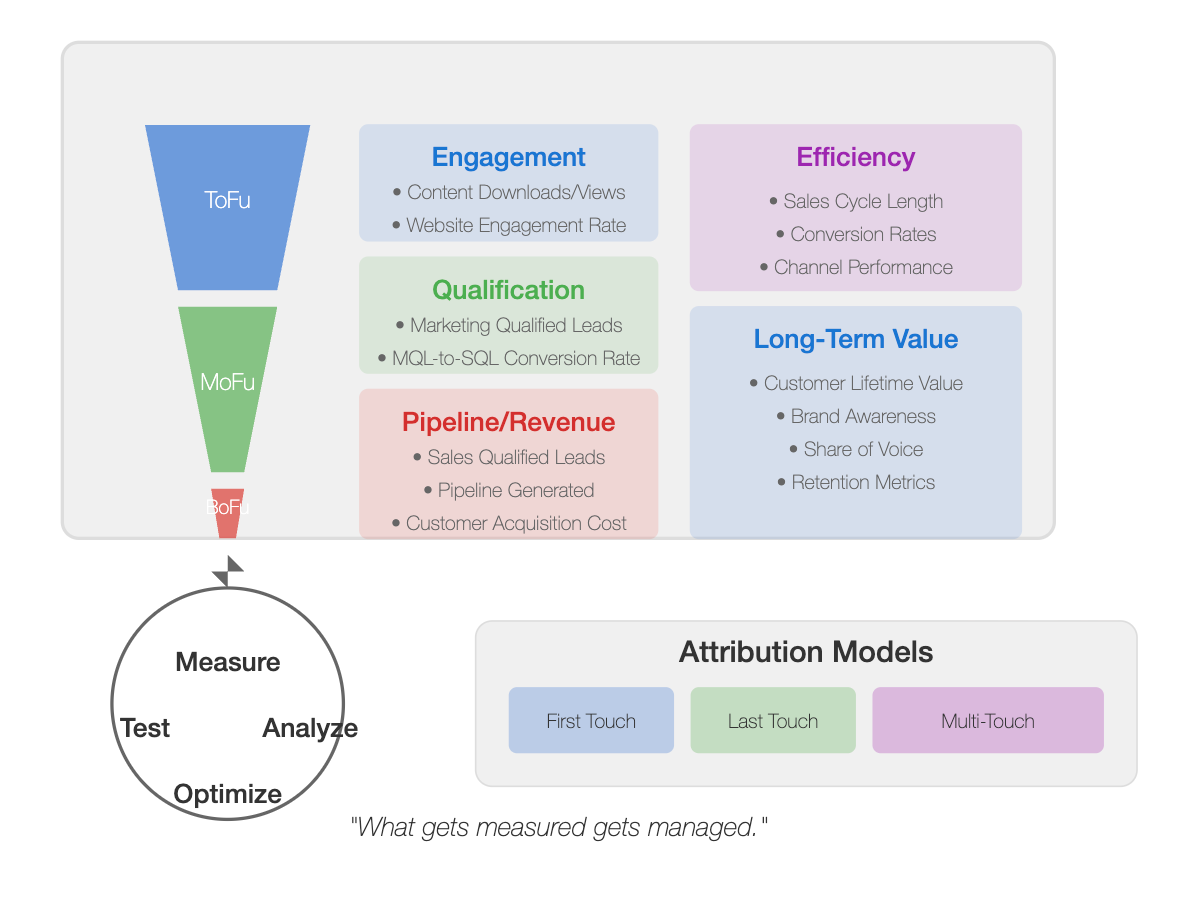A lot of B2B marketing feels… busy. Emails flying out. Social media posts scheduled. Ads running. Content being churned out. We generate activity. We generate reports. Sometimes, we even generate leads. But are we generating genuine demand? Is the phone ringing because prospects are genuinely intrigued, educated, and leaning towards us before we even know their name? Or are we just adding to the relentless digital noise, hoping something sticks?

It's a tough question. The pressure to deliver leads – any leads – can be immense. Sales needs pipeline. Management wants growth. So we focus on the bottom of the funnel, gating everything, chasing MQLs (Marketing Qualified Leads) that often turn out to be lukewarm at best. Sound familiar? This constant scramble for immediate results often misses the bigger picture. It neglects the crucial, foundational work of building real interest and preference in the marketplace before a prospect is ready to buy.
That foundational work? That’s demand generation. And it's fundamentally different from just chasing leads. Here at DataDab, we see companies wrestle with this distinction every day. It’s not just semantics; it’s a strategic shift that separates businesses merely surviving from those achieving sustainable, predictable growth. Forget the short-term hacks for a moment. Let's talk about building something lasting. Let's talk about creating an environment where your ideal customers want to engage with you, long before they fill out a form.

What is Demand Generation (Really)?
Okay, let's clear the air. Demand generation isn't just a fancier term for lead generation. While lead gen is a part of demand gen, it’s not the whole story. Think of it like this: Lead generation is asking someone for their phone number five minutes after meeting them. Demand generation is building a relationship first – demonstrating value, building trust, becoming a familiar, welcome presence – so that when the time is right, sharing contact information feels like the natural next step.
| Feature | Demand Generation Focus | Lead Generation Focus |
|---|---|---|
| Primary Goal | Create awareness, desire, and preference for solutions | Capture contact information from interested prospects |
| Target Audience | Entire potential market (including those unaware of need) | Prospects actively showing buying intent / researching solutions |
| Key Tactics | Brand building, educational content (often ungated), SEO, thought leadership, community engagement, nurturing | Gated content (high-value), demo requests, contact forms, targeted ads (bottom-funnel keywords) |
| Time Horizon | Long-term relationship building | Short-to-medium term conversion |
| Core Metric Example | Pipeline influenced, Share of Voice, MQL-to-SQL Rate | Cost Per Lead (CPL), Marketing Qualified Leads (MQL) Volume |
Demand generation is the umbrella strategy focused on creating awareness and desire for your company's products or services across the entire buyer journey. It’s about shaping perception, educating the market, and positioning your brand as a trusted authority and the go-to solution before a buyer actively enters a buying cycle. It aims to make your target audience aware of their problems (sometimes problems they didn't even know they had) and aware that you offer a compelling solution. The goal isn't just to capture existing demand (people already searching for your solution) but to create new demand by highlighting challenges and possibilities.
Contrast this with traditional lead generation, which often focuses narrowly on capturing contact information from prospects already showing buying intent (e.g., requesting a demo, downloading a comparison sheet). Demand generation casts a wider, more strategic net. It involves activities like brand building, content marketing aimed at education and awareness (often ungated), thought leadership, community building, and nurturing prospects who aren't ready to buy yet. It's playing the long game, understanding that most of your potential market isn't actively looking to purchase right now, but they will be eventually. Your job is to be top-of-mind and highly regarded when that time comes.
Essentially, demand generation warms up the market. It educates and engages potential buyers at the top (Awareness) and middle (Consideration) stages of the funnel, ensuring that when they do reach the bottom (Decision) stage, they are not only aware of you but predisposed to choose you. This results in leads that are not just numerous, but also higher quality, better educated, and more likely to convert into actual business.

Why Demand Gen Matters More Than Ever
The B2B landscape isn't what it used to be. The old playbook of simply hammering prospects with sales calls and generic emails is increasingly ineffective. Several converging trends make a strategic demand generation approach not just beneficial, but essential for survival and growth in today's market. Ignoring these shifts means falling behind competitors who understand how modern B2B buyers operate.
Firstly, the B2B buying journey has become significantly longer and more complex. Buyers are conducting extensive research independently long before they ever contact a vendor. Gartner research indicates that B2B buyers spend only 17% of their total purchase journey time meeting with potential suppliers. The rest of the time? They're researching online, talking to peers, and consuming content. Furthermore, the average buying group for a complex B2B solution now involves 6 to 10 decision-makers (Gartner), each bringing their own perspectives and research. This means your marketing needs to reach and resonate with multiple personas across an extended period, building consensus and preference gradually. Demand generation, with its focus on valuable content and consistent brand presence, is perfectly suited to nurture these complex, non-linear journeys.
Secondly, we live in an era of information overload. Buyers are bombarded with marketing messages from every conceivable channel. Cutting through this noise requires more than just a clever subject line or a flashy ad. It requires providing genuine value, building trust, and establishing credibility over time. Buyers are increasingly skeptical and self-reliant. They don't want to be "sold to"; they want to be educated and empowered to make the right decision. Demand generation focuses on becoming that trusted resource. By consistently sharing insightful content, expert perspectives, and helpful resources – often without asking for anything immediate in return – you build brand affinity and differentiate yourself from competitors who are still focused solely on the hard sell. This educational approach ensures that when buyers are ready to engage, they see you as a knowledgeable partner, not just another vendor clamoring for attention.
Finally, economic pressures and the demand for demonstrable ROI mean marketing functions are under greater scrutiny. Chasing large volumes of low-quality leads is expensive and inefficient. Sales teams waste valuable time filtering through prospects who aren't a good fit or aren't ready to buy. Demand generation, by focusing on attracting and nurturing the right audience and warming them up before the handover to sales, leads to higher conversion rates and a more efficient sales process. According to HubSpot, nurtured leads make 47% larger purchases than non-nurtured leads. By investing in building genuine demand, you create a more predictable pipeline of qualified opportunities, ultimately improving your Customer Acquisition Cost (CAC) and maximizing your marketing return on investment. It shifts the focus from short-term volume metrics to long-term value creation.
The Pillars of Effective Demand Generation
Building a successful demand generation engine isn't about finding a single magic bullet. It's about orchestrating several key components that work together synergistically. Neglecting any one of these pillars can undermine the entire structure. Let's break down the essential elements:
| Buyer Journey Stage | Primary Goal | Example Content Types | Typical Gating Strategy |
|---|---|---|---|
| Top of Funnel (ToFu) | Awareness, Education, Problem ID | Blog Posts, Infographics, Social Media Updates, Short Videos, Industry Reports (Summaries), Ungated Thought Leadership Articles | Primarily Ungated |
| Middle of Funnel (MoFu) | Solution Exploration, Comparison | Webinars, In-depth Guides, Case Studies, White Papers, Checklists, ROI Calculators, Ebooks, Gated Expert Interviews | Often Gated (Value Exchange) |
| Bottom of Funnel (BoFu) | Vendor Selection, Validation | Product Demos, Free Trials, Pricing Pages, Implementation Guides, Detailed Case Studies (Specific Results), Customer Testimonials, Consultation Offers | Often Gated / Requires Direct Contact |
1. Deeply Understanding Your Ideal Customer Profile (ICP)
This is the absolute foundation. You cannot generate demand if you don't know who you're trying to reach and what motivates them. Forget generic demographics. You need to go deep.

- Who are they? Job titles, company size, industry verticals.
- What are their biggest pain points and challenges? What keeps them up at night related to the problems you solve?
- What are their goals and aspirations? What does success look like for them?
- Where do they hang out online? LinkedIn groups? Specific industry forums? Certain publications? Niche communities?
- What triggers their search for a solution like yours? Internal pressures? Market shifts? Competitive threats?
- Who influences their decisions? What does the buying committee look like?
Creating detailed buyer personas based on research (interviews with current customers, sales team insights, market data) is non-negotiable. Without this clarity, your content will be generic, your channel choices ineffective, and your messaging will miss the mark.
2. Content That Resonates and Educates
Content is the fuel for your demand generation engine. But not just any content. It needs to be valuable, relevant, and mapped to the different stages of the buyer's journey.

- Top of Funnel (Awareness): Focus on the prospect's problems, not your product. Think blog posts addressing industry trends, insightful infographics, short educational videos, thought leadership articles, participation in relevant online discussions. Often, this content should be ungated to maximize reach and build initial trust.
- Middle of Funnel (Consideration): Now that they're aware of the problem and starting to explore solutions, offer deeper dives. Webinars, comprehensive guides, case studies demonstrating ROI, white papers exploring solutions in detail, checklists, interactive tools. Gating some of this content can be appropriate to identify interested prospects, but always ensure the value exchange is clear.
- Bottom of Funnel (Decision): This is where you connect your solution directly to their needs. Product demos, free trials, detailed pricing information, comparison sheets, implementation guides, customer testimonials.
The key is consistency and quality. Your content should position you as a helpful expert, building credibility long before a sales conversation begins. According to the Content Marketing Institute, 70% of B2B marketers say content marketing has improved their lead quality.
3. Choosing (and Mastering) the Right Channels
Where does your ICP spend their time? That's where you need to be. A multi-channel approach is usually best, but focus your efforts rather than spreading yourself too thin.

| Strategic Goal | Primary Channels (Examples) | Secondary Channels (Examples) | Considerations |
|---|---|---|---|
| Brand Awareness / Thought Leadership | LinkedIn (Organic), SEO (Blog Content), Industry Publications, Podcasts | PR, Speaking Engagements, Select Social Media | Focus on reach, consistency, valuable insights |
| Audience Engagement / Nurturing | Email Marketing, LinkedIn Groups, Webinars, Retargeting Ads | Community Forums, Personalized Content Hubs | Focus on value exchange, segmentation, interaction |
| High-Intent Lead Capture | SEO (Bottom-funnel keywords), Google Ads, Gated Content (MoFu/BoFu), Demo Request Pages | LinkedIn Lead Gen Forms, Direct Outreach Support | Focus on clear calls-to-action, low friction |
| Account-Based Marketing (ABM) Targeting | LinkedIn Ads (Account Targeting), Direct Mail, Personalized Email, Sales Navigator Outreach | Targeted Content Syndication, Virtual Events | Focus on personalization, coordination w/ Sales |
- LinkedIn: Often crucial for B2B. Organic posts, targeted advertising, participating in groups, Sales Navigator for targeted outreach.
- SEO: Ensuring your valuable content is discoverable when prospects search for solutions or information related to their pain points. This is a long-term play but essential for organic demand.
- Email Marketing: Not just for blasting offers. Use it for nurturing sequences, sharing valuable content, newsletters, and personalized communication. Segmentation is key.
- Industry Communities/Forums: Where niche discussions happen. Participating authentically (not just promoting) can build significant credibility.
- Webinars/Virtual Events: Excellent for showcasing expertise and engaging prospects in real-time.
- Targeted Paid Advertising: Platforms like LinkedIn Ads, Google Ads (targeting specific keywords), and even niche industry publications allow you to reach specific segments of your ICP.
- Podcasts/Video: Increasingly popular formats for consuming educational content.
Don't just broadcast. Engage. Participate. Build relationships within these channels. The goal is to become a recognized and respected voice where your ideal customers are already learning and networking.
4. Nurturing Relationships Over Time
Remember, most of your market isn't ready to buy today. Demand generation involves nurturing these potential future customers, keeping your brand top-of-mind, and providing continuous value until they are ready.

- Marketing Automation: Tools like HubSpot, Marketo, or Pardot are invaluable for managing nurturing workflows.
- Email Nurturing Sequences: Segment your audience based on interests, behavior, or persona, and deliver targeted email sequences offering relevant content over weeks or months.
- Retargeting: Use targeted ads to stay in front of prospects who have visited your website or engaged with your content.
- Personalization: Go beyond
[First Name]. Tailor content recommendations and messaging based on known data points and observed behavior.
Nurturing builds trust and ensures that when a prospect's need becomes urgent, you are the first solution they think of. It bridges the gap between initial awareness and sales readiness.
5. Tight Sales and Marketing Alignment (Smarketing)
Demand generation cannot succeed if marketing and sales operate in silos. They must function as a single, cohesive revenue team.

- Shared Definitions: Agree on what constitutes an ICP, a Marketing Qualified Lead (MQL), and a Sales Qualified Lead (SQL).
- Service Level Agreements (SLAs): Define responsibilities. How quickly will marketing follow up on inquiries? How quickly will sales follow up on MQLs? What feedback loops are in place?
- Regular Communication: Frequent meetings to discuss campaign performance, lead quality, market feedback, and upcoming initiatives.
- Shared Goals and Metrics: Both teams should be measured on pipeline generated and revenue closed, not just siloed metrics like lead volume or calls made.
- Feedback Loops: Sales must provide feedback to marketing on lead quality and conversation outcomes. Marketing must inform sales about campaigns and content nurture paths.
Companies with strong sales and marketing alignment achieve significantly better results. SiriusDecisions (now part of Forrester) famously reported that aligned organizations achieve up to 19% faster revenue growth and 15% higher profitability.

6. Measurement and Continuous Optimization
What gets measured gets managed. Demand generation requires a shift away from vanity metrics towards metrics that reflect real business impact.
| Metric Category | Specific Metric | What It Tells You | Primary Funnel Focus |
|---|---|---|---|
| Engagement | Content Downloads / Views | Interest level in specific topics/formats; content resonance | ToFu / MoFu |
| Engagement | Website Engagement Rate / Time on Page | Quality of traffic; how well content holds attention | ToFu / MoFu |
| Qualification | Marketing Qualified Leads (MQLs) | Volume of prospects meeting initial interest criteria | MoFu |
| Qualification | MQL-to-SQL Conversion Rate | Lead quality; effectiveness of nurturing; sales/marketing alignment | MoFu / BoFu |
| Pipeline/Revenue | Sales Qualified Leads (SQLs) | Volume of prospects deemed ready for sales engagement | BoFu |
| Pipeline/Revenue | Pipeline Generated (Marketing Sourced/Influenced) | Direct contribution of marketing efforts to potential revenue | BoFu |
| Pipeline/Revenue | Customer Acquisition Cost (CAC) | Efficiency of sales and marketing spend in acquiring new customers | Full Funnel |
| Efficiency | Sales Cycle Length | Speed of conversion process; potential bottlenecks | BoFu |
| Long-Term Value | Customer Lifetime Value (CLV) | Overall value derived from a customer; informs acquisition spend | Post-Purchase |
- Key Metrics:
- Website Traffic (by source)
- Content Engagement (downloads, views, time on page)
- Lead Quality (MQL-to-SQL conversion rate)
- Pipeline Generated (marketing-sourced and marketing-influenced)
- Sales Cycle Length
- Customer Acquisition Cost (CAC)
- Customer Lifetime Value (CLV)
- Brand Awareness/Share of Voice (more challenging, but trackable via surveys, social listening)
- Attribution: Understand which channels and campaigns are contributing to pipeline and revenue. Multi-touch attribution models provide a more realistic view than simple first-touch or last-touch models.
- Testing and Iteration: Continuously test different content formats, messaging, channels, and calls-to-action. Use A/B testing where possible. Analyze the data and optimize your strategy accordingly.
Below is a simplified table highlighting key metrics across the funnel stages:
| Funnel Stage | Goal | Example Metrics |
| Top (Awareness) | Reach & Engagement | Website Traffic, Social Reach/Engagement, SEO Rankings, Content Views/Shares, Brand Mentions |
| Middle (Consideration) | Interest & Qualification | Content Downloads (Gated), Webinar Registrations, MQLs Generated, MQL-to-SQL Rate, Email Open/Click Rates |
| Bottom (Decision) | Conversion & Revenue | SQLs Generated, Sales Opportunities Created, Demo Requests, Pipeline Value, Win Rate, CAC, Sales Cycle Length |
| Post-Purchase | Retention & Advocacy | Customer Lifetime Value (CLV), Upsell/Cross-sell Rate, Net Promoter Score (NPS), Customer Reviews/Testimonials |
Effective demand generation is an iterative process. Use data insights to refine your understanding of your ICP, improve your content, optimize your channel mix, and enhance your nurturing strategies.
Common Pitfalls to Avoid
Embarking on a demand generation strategy is exciting, but it's easy to stumble. Awareness of common mistakes can help you navigate more effectively and avoid wasted effort or disillusionment. Many companies fall into traps that sabotage their efforts before they gain momentum.

One major pitfall is an over-reliance on gated content, especially at the top of the funnel. While capturing leads feels productive, gating everything creates friction. Your best educational content, the kind designed to build awareness and trust with people not yet ready to buy, should often be freely accessible. If someone has to fill out a form just to read a basic blog post or watch an introductory video, they'll likely go elsewhere. This "lead gen first" mentality starves your top-of-funnel efforts, preventing you from building a broad audience and establishing thought leadership. Reserve gating for higher-value, middle- or bottom-funnel content where the prospect perceives a fair value exchange for their contact information.
Another common mistake is neglecting brand building in favor of direct response. Demand generation isn't just about triggering immediate actions; it's also about shaping long-term perception. Consistently showing up, providing value, having a distinct point of view, and engaging in relevant industry conversations builds brand equity. This 'dark social' activity – sharing insights on LinkedIn, participating in communities, creating memorable content – might not always generate a trackable lead immediately, but it builds familiarity and trust, making future conversions much easier. Companies solely focused on measurable, short-term MQLs often underinvest in these crucial, harder-to-measure brand-building activities that grease the wheels for the entire demand engine.
Finally, a lack of patience and unrealistic expectations can derail even well-conceived demand generation plans. Unlike some direct response tactics, demand generation is a long-term strategy. Building brand awareness, trust, and an engaged audience takes time. Seeing significant results in terms of high-quality pipeline might take months, even quarters, especially in industries with long sales cycles. If leadership expects a flood of sales-ready leads within weeks of launching a new content strategy or community engagement effort, disappointment is inevitable. It's crucial to set realistic timelines, communicate the long-term nature of the strategy, and focus on leading indicators (like content engagement, audience growth, website traffic from target accounts) while the lagging indicators (pipeline, revenue) develop.
Building Your Demand Engine
Feeling overwhelmed? Don't be. Starting or refining your demand generation strategy doesn't require boiling the ocean overnight. It's about taking deliberate, incremental steps based on a solid understanding of the principles. Here’s a practical way to begin:

- Revisit (or Create) Your ICP Deeply: Don't skim this. Conduct fresh interviews with recent customers (both wins and losses) and your sales team. What really drove their purchase? What alternatives did they consider? What content did they find most helpful? Document these insights rigorously. This is your compass.
- Audit Your Current Content and Channels: Look at your existing blog posts, white papers, webinars, etc. How well do they align with your ICP's pain points and the buyer's journey? Are you present and active on the channels where your ICP actually spends time? Identify gaps and opportunities. Where can you provide more value? Where is your message falling flat?
- Set Clear, Realistic Goals & KPIs: Based on your audit and ICP understanding, set specific, measurable goals. Don't just aim for "more leads." Aim for things like "Increase organic traffic to resource pages by 15% in Q3," or "Generate 20 qualified MQLs from the new webinar series," or "Improve MQL-to-SQL conversion rate from 10% to 15% within 6 months." Focus on a mix of leading and lagging indicators.
- Prioritize Sales & Marketing Alignment: Schedule a dedicated meeting between sales and marketing leadership. Review ICP definitions, lead qualification criteria (MQL/SQL), and the lead handoff process. Establish clear SLAs and agree on regular feedback sessions. This foundational alignment is critical before launching major new initiatives.
- Start Small, Test, and Iterate: You don't need to launch ten new initiatives at once. Pick one or two high-priority areas based on your audit (e.g., improving top-of-funnel blog content, launching a targeted LinkedIn campaign for a specific ICP segment). Execute well, measure obsessively, gather feedback, and then iterate or expand based on the results. Demand generation is a marathon, not a sprint; continuous learning and optimization are key.
The DataDab Difference
Navigating the complexities of B2B demand generation requires expertise, data-driven insights, and a strategic mindset. It's about connecting the dots between understanding your customer, creating compelling content, choosing the right channels, nurturing relationships, aligning teams, and measuring what truly matters.
At DataDab, this is precisely what we help B2B organizations achieve. We partner with companies like yours to move beyond random acts of marketing and build cohesive, effective demand generation engines. We bring a data-first approach, digging deep into your market, your customers, and your performance metrics to identify the highest-impact opportunities. Whether you need help defining your ICP, developing a content strategy that resonates, optimizing your channel mix, implementing marketing automation for nurturing, or fostering better sales and marketing alignment, our consulting services are designed to provide clarity and drive results. We believe in building sustainable growth, not just chasing fleeting metrics.
From Noise to Genuine Demand
The B2B landscape demands more than just activity. It demands strategy. It demands value. It demands a focus on building genuine interest and trust over time – the core tenets of demand generation. Shifting from a purely lead-centric model to a demand-centric one isn't always easy. It requires a change in mindset, a commitment to understanding your audience deeply, and patience to see the long-term results.
But the rewards are substantial: higher quality leads, shorter sales cycles, more efficient marketing spend, stronger brand reputation, and ultimately, more predictable and sustainable revenue growth. Stop adding to the noise. Start building real relationships, providing tangible value, and creating an environment where your ideal customers actively seek you out. That's the power of true B2B demand generation.
Ready to move beyond chasing leads and start building a robust demand generation engine for your B2B business? Let's talk. The team at DataDab is here to help you strategize and implement a plan that delivers real results.
FAQ
1. What is the real difference between demand generation and lead generation again?
Think of it this way: Lead generation focuses specifically on capturing contact information from people already showing interest, often near the bottom of the funnel. Demand generation is the broader, more strategic effort across the entire buyer journey. It involves creating awareness, educating the market, building trust, and shaping preference before a prospect is even ready to identify themselves. Lead generation is a component within demand generation, but demand gen aims to warm up the entire market, not just capture those already raising their hands.
2. How long does it actually take to see results from demand generation?
This requires patience, as it's a long-term strategy. Unlike some direct response tactics that might yield quick leads (of varying quality), building genuine demand takes time. You might see leading indicators like increased website traffic, better content engagement, or improved brand mentions within a few months. However, seeing a significant impact on high-quality pipeline (like qualified leads flowing consistently to sales) can often take six months to a year or even longer, especially in industries with complex products or long sales cycles. Setting realistic expectations is crucial.
3. Is gated content dead? Should we ungate everything?
Gated content isn't dead, but its overuse, especially at the top of the funnel, can hinder demand generation. The key is strategic gating. Your broad educational content, aimed at building awareness and trust (like blog posts or infographics), should largely be ungated to maximize reach. Reserve gating for higher-value, deeper-dive content where the prospect clearly understands the value exchange for their information – think comprehensive guides, webinars, ROI calculators, or case studies relevant to the middle or bottom of the funnel. It's about balance and respecting the buyer's journey.
4. My sales team just wants leads now. How do I get their buy-in for demand gen?
This is a common challenge rooted in alignment. Frame demand generation not as a replacement for leads, but as a way to generate better, more qualified leads that are easier for sales to close. Explain how warming up the market and educating prospects before the handover saves sales time wasted on unqualified contacts. Focus on shared goals, like pipeline quality and revenue growth, not just marketing's lead volume. Involve sales in defining the Ideal Customer Profile (ICP) and MQL/SQL criteria, and establish clear feedback loops so they see the connection between marketing's efforts and their success.
5. Which channels are most important for B2B demand generation?
There's no single "most important" channel; it entirely depends on where your Ideal Customer Profile (ICP) spends their time and seeks information. However, for many B2B contexts, LinkedIn is often critical for reaching professionals, sharing thought leadership, and targeted advertising. Search Engine Optimization (SEO) is fundamental for capturing intent when prospects are actively researching solutions. Beyond these, consider industry-specific communities, relevant publications, email nurturing, webinars, and potentially targeted paid media. The best strategy involves understanding your specific audience's behaviour and using a relevant multi-channel approach.
6. How much should we budget for demand generation?
Budgeting varies significantly based on industry, company size, growth goals, and competitive landscape. A common benchmark suggests B2B companies allocate anywhere from 5% to 15% of their overall revenue towards marketing, a significant portion of which should support demand generation activities. Instead of viewing it purely as a cost center, consider it an investment in future pipeline and brand equity. Focus on funding activities that align with your strategic goals and ICP engagement, and be prepared to measure ROI based on pipeline influence and revenue impact, not just lead volume.
7. Can a small business effectively implement demand generation?
Absolutely. Demand generation principles are scalable. A small business might not have the resources for massive multi-channel campaigns, but they can be highly effective by focusing intensely. Start with a crystal-clear ICP definition. Prioritize one or two channels where that ICP is most active. Create high-quality, genuinely helpful content addressing their specific pain points. Focus on building relationships within a niche community. Consistency and focus often yield better results than trying to do everything with limited resources.
8. What are the most critical metrics to track for demand generation success?
Move beyond vanity metrics like raw website visits or social media likes. Focus on metrics that indicate true business impact and progression through the funnel. Key metrics include: MQL-to-SQL conversion rate (indicates lead quality and alignment), marketing-sourced and marketing-influenced pipeline value (shows contribution to potential revenue), Customer Acquisition Cost (CAC) (measures efficiency), and Sales Cycle Length (how quickly deals are closing). Tracking content engagement for specific ICP segments can also be a valuable leading indicator.
9. How important is brand building within demand generation? Isn't that just 'fluff'?
Brand building is far from fluff; it's a crucial, foundational element of effective demand generation. A strong, trusted brand warms the market, making prospects more receptive to your messaging and outreach later on. When buyers recognize and respect your brand because they've consistently seen valuable insights from you (even if they never clicked a specific ad), it shortens sales cycles and increases win rates. It builds trust and familiarity, differentiating you from competitors before a formal sales process even begins. It’s the bedrock upon which specific campaigns are built.
10. What's the first step I should take if I want to improve my company's demand generation?
The single most impactful first step is to rigorously define or refine your Ideal Customer Profile (ICP). Don't rely on assumptions. Conduct interviews with your best customers, talk extensively with your sales team about who closes best and why, and analyze your data. Understanding precisely who you're trying to reach, their deepest pain points, their goals, and where they seek information provides the necessary foundation for all subsequent demand generation activities, from content creation to channel selection. Get this right first.



